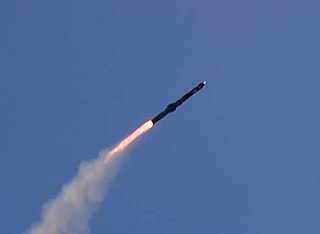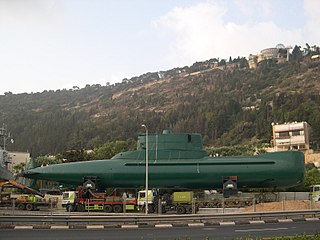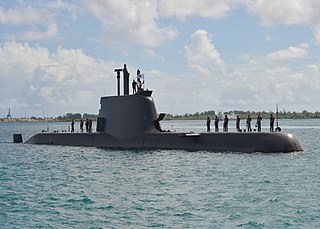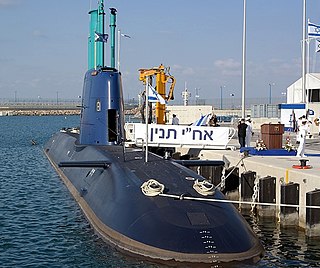
The Type 212A is a class of diesel-electric submarine developed by Howaldtswerke-Deutsche Werft AG (HDW) for the German Navy, and the Italian Navy where it is known as the Todaro class. It features diesel propulsion and an additional air-independent propulsion (AIP) system using Siemens proton-exchange membrane (PEM) compressed hydrogen fuel cells. The submarines can operate at high speed on diesel power or switch to the AIP system for silent slow cruising, staying submerged for up to three weeks with little exhaust heat. The system is also said to be vibration-free and virtually undetectable.

A cruise missile submarine is a submarine that carries and launches cruise missiles as its primary armament. Missiles greatly enhance a warship's ability to attack surface combatants and strike land targets; although torpedoes are a more discrete option for submerged submarines, missiles give a much longer stand-off range, shorter time to impact the target, as well as the ability to engage multiple targets on different headings at the same time. Many cruise missile submarines retain the capability to deploy nuclear warheads on their missiles, but they are considered distinct from ballistic missile submarines due to the substantial differences between the two weapons systems' flight characteristics; cruise missiles fly aerodynamically using flight surfaces like wings or fins, while a ballistic missile uses its engine power alone as it may exit the atmosphere.

A vertical launching system (VLS) is an advanced system for holding and firing missiles on mobile naval platforms, such as surface ships and submarines. Each vertical launch system consists of a number of cells, which can hold one or more missiles ready for firing. Typically, each cell can hold a number of different types of missiles, allowing the ship flexibility to load the best set for any given mission. Further, when new missiles are developed, they are typically fitted to the existing vertical launch systems of that nation, allowing existing ships to use new types of missiles without expensive rework. When the command is given, the missile flies straight up far enough to clear the cell and the ship, then turns onto the desired course.

The RUM-139 Vertical Launch Anti-Submarine Rocket is an anti-submarine missile in the ASROC family, currently built by Lockheed Martin for the U.S. Navy.

The Dolphin class is a diesel-electric submarine developed in Israel and constructed by Howaldtswerke-Deutsche Werft AG (HDW) in Kiel, Germany, for the Israeli Navy. The first boats of the class were based on the export-only German 209-class submarines, but modified and enlarged. The Dolphin 1 sub-class is slightly larger than the German Navy Type 212 in length and displacement. The three newer air-independent propulsion (AIP) equipped boats are similar to the Type 212 vessels in underwater endurance, but are 12 metres (39 ft) longer, nearly 500 tonnes heavier in submerged displacement and have a larger crew than either the Type 212 or the Type 214.

The Israeli Navy is the naval warfare service arm of the Israel Defense Forces, operating primarily in the Mediterranean Sea theater as well as the Gulf of Eilat and the Red Sea theater. The current commander in chief of the Israeli Navy is Aluf David Saar Salama. The Israeli Navy is believed to be responsible for maintaining Israel's offshore nuclear second strike capability.

The Type 540 Gal-class submarine is a slightly modified variant of the German HDW Type 206 submarine class, modified for Israeli requirements. The Gal class submarines were built to Israeli specifications as the Vickers Type 540 at the Vickers shipyards in Barrow-in-Furness in the UK rather than Germany for political reasons. "Gal" was the name of the son of Abraham (Ivan) Dror, 3rd commander of the squadron and head of the project.

The Republic of China Navy, also called the ROC Navy and retroactively as the Chinese Navy but colloquially as the Taiwan Navy, is the maritime branch of the Republic of China Armed Forces (ROCAF).

The Type 214 is a class of diesel-electric submarines developed exclusively for export by Howaldtswerke-Deutsche Werft GmbH (HDW). It features diesel propulsion with an air-independent propulsion (AIP) system using Siemens polymer electrolyte membrane (PEM) hydrogen fuel cells. The class combines the design principles of the Type 209 submarine family and the features of the Type 212A submarine. However, as an export design, it lacks some of the classified technologies of the Type 212 such as the non-magnetic steel hull that makes it difficult to detect using a magnetic anomaly detector.

The Royal Saudi Navy or Royal Saudi Naval Forces, is the maritime arm of the Saudi Arabian Armed Forces and one of the five service branches of the Ministry of Defense of Saudi Arabia. Its primary role is monitoring and defending the Saudi territorial waters against military or economic intrusion, and participating in international naval alliances.

The Mark 41 Vertical Launching System is a shipborne missile canister launching system which provides a rapid-fire launch capability against hostile threats. The Vertical Launch System (VLS) concept was derived from work on the Aegis Combat System.
The Type 216 is a submarine design concept announced by Howaldtswerke-Deutsche Werft based on the Type 212/214.
The Invincible-class submarines, formally classified as the Type 218SG submarines, is a class of conventionally-powered attack submarines, ordered by the Republic of Singapore Navy (RSN) from German-based naval conglomerate ThyssenKrupp Marine Systems (TKMS). The Type 218SG is an extensively-customised derivative of the export-oriented Type 214 submarine, with specific design characteristics drawn from Type 212 submarines. They feature several capabilities, including a substantial level of automation, a significant payload capacity, enhanced underwater endurance and superlative ergonomics.

INS Tanin is an Israeli Dolphin 2-class submarine. The name means "crocodile" in modern Hebrew, but can also mean the sea monster "tannin". The submarine was launched in February 2012 in Kiel, Germany, and was delivered to the Israeli port city Haifa later that year, and entered service in 2014.

INS Rahav is an Israeli Dolphin 2-class submarine. The name is Hebrew for "Rahab." The submarine was built in Kiel, Germany, and delivered to the Israeli port city Haifa 12 January 2016, where entered service the next day.

The Sa'ar 6-class corvette is a series of four German-made corvettes ordered for the Israeli Navy in May 2015.

The KSS-III or Dosan Ahn Changho-class is a series of diesel-electric attack submarines currently being built for the Republic of Korea Navy (ROKN), jointly by Hanwha Ocean and HD Hyundai Heavy Industries (HHI). The KSS-III is the final phase of the Korean Attack Submarine program, a three-phased program to build 27 attack submarines for the ROKN, between 1994–2029.
The Type 212CD class is a submarine class developed by ThyssenKrupp Marine Systems (TKMS) for the Norwegian and German navies. The class is derived from the Type 212 submarine class, but will be significantly larger than the 212 class.

The SSN-AUKUS, also known as the SSN-A, is a planned class of nuclear-powered fleet submarine (SSN) intended to enter service with the United Kingdom's Royal Navy in the late 2030s and Royal Australian Navy in the 2040s. The class will replace the UK's Astute class and Australia's Collins class submarines.
The Dakar-class submarine is a class of AIP-capable, diesel-electric attack submarines ordered by the Israeli Navy from German-based naval conglomerate ThyssenKrupp Marine Systems (TKMS).
















